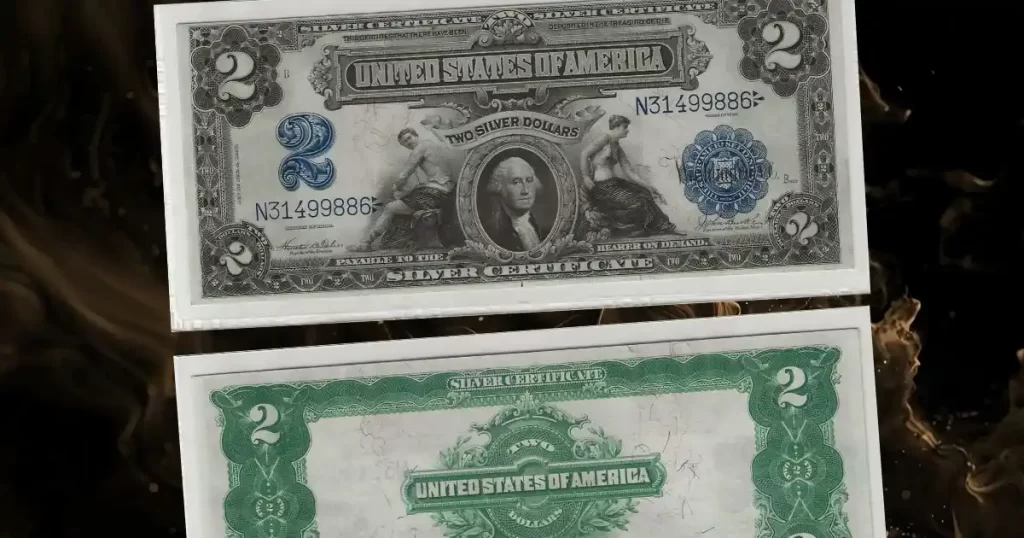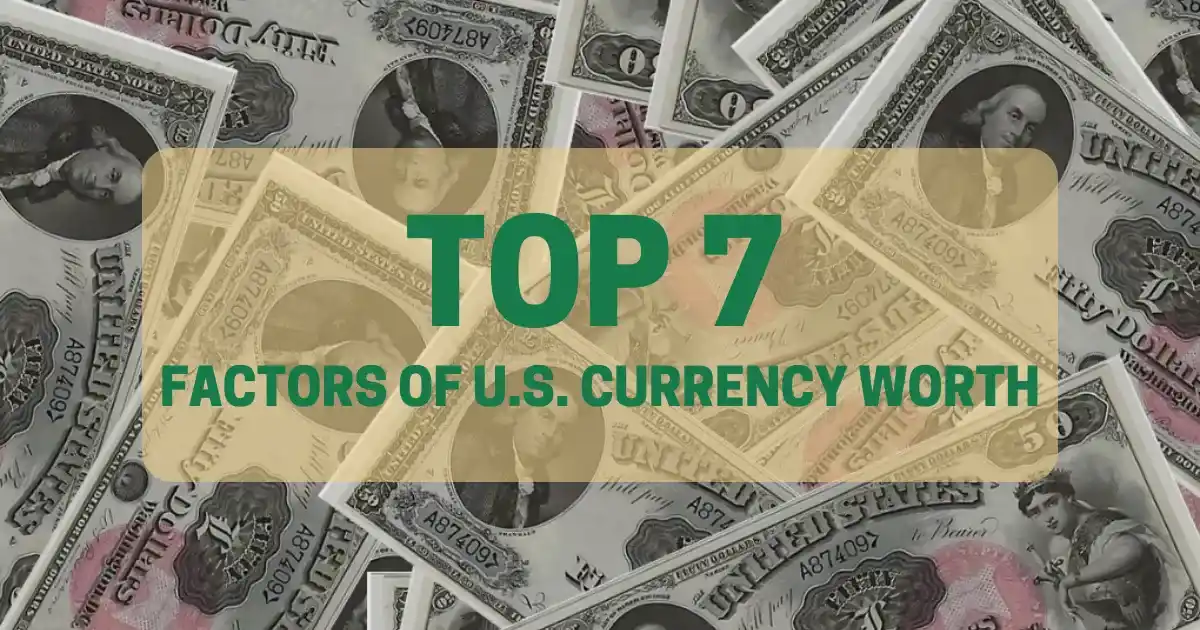Most of us will consider as Paper Currency cash. We use them every day to make purchases. These notes can be interesting if you explore their history and beautiful artwork. Some of these notes are quite rare and valuable, as relatively few of them were produced. As the demand for these rare banknotes continues to increase, so does their price range, which can go up to millions of dollars. Because of their importance in history, distinct characteristics, and scarcity, these banknotes are in high demand and have a lot of worth. So whether you are an experienced numismatist or just an interested buyer, you must know how much banknotes become valuable.
In this blog, we are going to discuss the 7 most essential pieces of information that tell the real worth of rare US banknotes, and also how you can see them.
1. Historical Significance:
One of the primary factors that elevate the worth of rare U.S. banknotes is their historical importance. Many banknotes were issued during key moments in American history—such as during wartime, economic crises, or major political changes. For example, the 1861 Demand Notes were the first paper currency issued by the U.S. government during the Civil War. These notes are highly sought after by collectors because they represent a pivotal moment in American history, and their limited circulation makes them rare today.
Another notable example is the 1934 $500 and $1,000 notes, which were issued to facilitate large transactions during the Great Depression. Although these high-denomination bills were discontinued in 1969 due to inflation and their role in illegal activities, they have since become prized collector’s items.

2. Rarity and Limited Circulation:
Banknotes of the USA which are rare can be worth a lot of money especially when they are on the market and one thing that adds value to them is their relevance in history. On several occasions, such notes have been issued during, wars, economic crises, or political turmoil. For instance, in the US Civil War, the Demand Note was the first paper currency issued by the US government in 1861. This type of note will be very popular with collectors as it would provide them with a very important time in US history, and due to the unavailability of these notes, very few can be found.
The 1934 $500 and $1000 notes can be considered as an interesting case in point. This note was issued because of the need to carry out large transactions during the time of the Great Depression. Although these high-denomination bills were phased out in 1969 owing to hyper-inflationary solutions and their association with crimes, today these bills are quite popular among collectors.

3. Unique Design Features:
Another important aspect of banknote value is the printing details. It is common that notes of past eras, such as the $5 “Red Seal” Treasury note of 1862, are sought after for their beautiful illustrations and detailed designs. Such notes are coupled with stylized borders and emblems, alongside the images of historical persons like Alexander Hamilton, one of the founding fathers of the United States.
The Gold Certificates that were issued in 1928 portray several features of the United States that differ from other currencies. With these notes, one of the most important changes was that these notes were backed by precious metals like ‘’Gold’’. The unusual appearance of these bills makes them very sought after by collectors, especially in good condition. Together with the beautiful patterns, the lack of such money makes them an excellent piece for any collector.

4. Condition and Grading:
Another very important element used to describe the worth of a banknote is its state. Notes that remain in very good condition can be sold at much higher prices. Collectors and dealers assess the condition of a banknote or number of banknotes using a method known as grading. Grading is a system that places the condition of notes on a scale that ranges from ‘Poor’ to ‘Uncirculated.’
A relevant instance is an unbeaten 1882 $1,000 “Grand Watermelon Note,” which can be sold for over one million dollars, however, one that is battered can be valued for only, at most, $10,000. In such instances, one can find certain resources that will explain those notes, their value, and the level of demand in the noted context of suffering and struggle, such as the Condition Census which is replicated in the form of lists.

5. Celebrity Notes and Unique Serial Numbers:
The unique “celebrity” serial numbers also make U.S. currency more valuable. Certain serial numbers are coveted for having repeating digits, such as the numbers 11111111 or 00000001. These types of serial numbers are so rare that collectors will pay top dollar to obtain one, and sometimes these numbers sell for a significant premium over the face value at auction.
Besides serial numbers that repeat digits, low serial numbers, such as 00000001, raise the value of a note dramatically. For example, a $1,000 bill bearing the serial number 00000001 was sold for more than $2 million in an auction. These become precious to collectors because of their uniqueness and aesthetic worth.

6. Cultural and Economic Impact:
Some of the extremely rare US banknotes carry significant cultural or economic value. For instance, the series 1896 $5 “Educational Series” Note is known not only for its rarity but also for its artistic message. Allegorical representations of “Electricity as the Dominant Force in the World” and “Science Presents Steam and Electricity to Commerce and Manufacture” are embossed into this note, making it a piece of American currency history.
Notes linking historical events and persons of U.S. history hold more distinct value than those from their scarcity. For instance, notes featuring portraits of the U.S. Presidents, founding fathers, and other historical figures are likely to be precious because of their association with American heritage.

7. Artistic Worth and Craftsmanship:
Rare Paper Currency is more than a medium of monetary exchange or value. It represents a canvas of the history, culture, and customs of a nation in different periods. For Collectors and Enthusiasts, the value of these notes lies not only in their rarity, and historical context but also in their unique and creative artwork. Each piece of currency tells a new story through its intricate designs, unique colors, and beautiful allegorical figures.
Portraits of great historical figures and engraved borders give every note a unique effect representing extraordinary craftsmanship. The vibrant hues and colorful seals with matching or contrasting serial numbers show the evolution of technology and art over the centuries.
From the bold 19th-century engravings of US Large Size Notes to the delicate shine and flourish of Gold and Silver Certificates embodying the fusion of functionality and beauty. Some of these are collected because of their unique and bold security features making them rare.

FAQs:
Q1: What are the features that make a U.S. banknote rare?
A U.S. banknote is considered rare if it lacks circulation, is tied to a historic event, or possesses distinctive design features. Other contributing factors might be misprints, special serial numbers, or unique series.
Q2: What effect does the condition have on the value of the banknote?
The grade or condition of a banknote is critical in determining its value. Those that are very fine and display almost no signs of wear are much higher in value than those that are highly worn. Banknotes are graded on a scale from “Poor” to “Uncirculated.” Everything above the “Poor” grade gets a premium.
Q3: What’s a star note? Why are they valuable?
Star notes are replacement bills that were printed to replace damaged or misprinted notes. They carry a star symbol at the end of a serial number. Due to being a replacement, they are rarer and more valuable to collectors.
Q4: Do low serial numbers have a higher value?
Yes, low serial numbers, especially those with the prefix “00000001,” are highly valuable to collectors. These tend to be unique or “celebrity” items, and that alone causes bidding wars at auctions, driving up their value.
Q5: Why are certain U.S. banknotes historically linked to such great value?
In addition, banknotes that are issued during important epochs, for example, wars or periods of major financial decline, command a premium price because they are fundamentally historical documents. For example, bills printed out during the Civil War or the Great Depression may be highly valuable due to their contribution to American history.
Q6: How do the design elements of a banknote impact its value?
U.S. banknotes are unique, especially for early issues, in terms of their designs. Notes such as the 1899 $5 “Red Seal” Note are rare and highly prized for their unique designs and elaborate borders standard for earlier currency.
Q7: Is investing in rare U.S. banknotes profitable?
Yes, investments in rare U.S. banknotes are very profitable. Rare currencies tend to appreciate over time. It is a proven fact that sales of rare notes, for instance, in 1890 $1,000 Grand Watermelon Note fetched millions of money.



